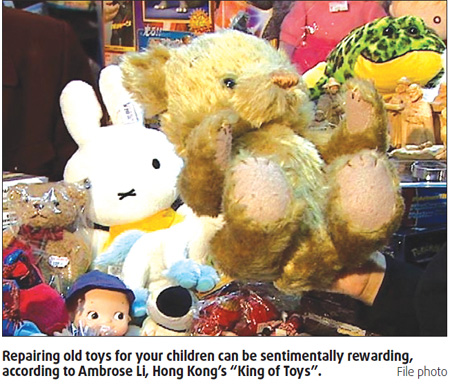Kid's play for a better world
Updated: 2010-01-23 07:26
By Simon Chau(HK Edition)
|
|||||||

When I was thirteen, a 14-inch battery-powered speedboat sitting in the window of a corner bookstore (there were no toy shops then) captured my imagination every day on my way home from school. It became a super-luxury item that turned up in my dreams time and time again. It cost $33, when my father was earning some $550 per month to support the family of six. Eventually, the object of desire entered my life on my birthday, only to be ignored and allowed to rust in a matter of weeks as I got tired of it.
Twenty years down the road, our toddler daughter was obsessed with the only toy in her possession: an old 14-inch wooden salad spoon discovered in the kitchen. That thing hypnotized her for hours on end everyday for more than a year.
She and her brother taught us a lot about child psychology and green living. Given the fact that toys play a vital role in the nurturing of our younger generations, and they are inheriting the planet we leave them, it is important to choose your children's toys wisely.
I'd now like to share the following ideas we have gleaned after thirty years of parenting and green activism.
How to choose green toys
1. Safety - Despite universal condemnation and international bans, more and more deadly chemicals are employed in toy manufacturing these days. Make sure that art materials (paints, crayons, clay, etc.) in the little ones' hands are water-based and low-VOC or no-VOC.
2. Health - The children of today are too often glued to the screen, or classroom desk. They need more toys that encourage them to develop their kinesthetic intelligence.
3. Bonding with nature - A humble rope for skipping in the neighborhood park would be far better than hi-tech gadgets that will keep them indoors. Miniature garden tools grow green fingers. In addition to being potentially toxic, all plastics, artificial fabrics and painted metals won't help in cultivating a fondness for Nature in the budding minds. Toys made of wood, paper, bamboo, cotton (e.g. stuffed toys) and stone (for painting, etc.) work wonders in this respect.
4. Eco-footprint - Commercialized toys often consume huge amounts of energy and material resources in the manufacturing, packaging, promotion and transportation. Caring for the planet means choosing ones that come with minimal packaging and lots of recycled and organic materials. Durability (i.e. its ability to keep children's interest and its potential longevity) also count. Battery-run toys are particularly undesirable in this sense. Batteries have become standard in most toys today. Not only are they particularly nasty in our landfills, and will remain so for centuries to come, many of them are noisy. If your child must have the newest electronic gadget, consider using rechargeable batteries.
5. Green ideology - Action figures, toy guns and war-themed video games encourage violent tendencies and promote militaristic values. Commercialized brand name dolls that represent women as sexual objects do not help in nurturing healthy human relationship. Board games involving investment strategies that supposedly develop entrepreneurship could strengthen materialistic goals (greed) in life. Some card games may create gambling habits in our young ones.
6. DIY - The "greenest" toys, undoubtedly, are the ones family members invent or hand-make themselves out of existing materials. Encourage your children to invent their own toys out of used materials - juice cartons, egg trays, metal moon cake boxes (to be landfilled after the festival), random pieces of string. This not only taps into your children's creativity, but will also teach them green values.
My father, turning 90 soon, may never realize the value of that birthday present he bought me. While it bored me after a few times' playing, the lesson was enduring: a worthy toy is one which you can do things with it, and have fun in the process. As our young daughter taught me back then, you don't need designers and factories and complicated gadgets and TV promotion slots to fascinate kids and keep them entertained. Cardboard boxes that refrigerator and washing machine were delivered in became her playhouse, castle, and submarine. While staying with families over Christmas in Britain, time and again I witnessed kids fascinated by the boxes while ignoring the gifts inside.
Ask any sane child, and she will tell you that rather than TV and iPods, she would prefer her parents to play hide-and-seek, Lego, or make music with them. My children often remind me that I am their greatest toy and source of joy. (The affectionate family dog comes a close second.)
Dr Chau chairs LifeFlow and Produce Green Foundation. He can be contacted at Simon@Simonchau.hk.
(HK Edition 01/23/2010 page3)